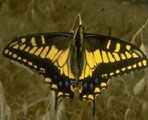Native Plants
Search for native plants by scientific name, common name or family. If you are not sure what you are looking for, try the Combination Search or our Recommended Species lists.
Heracleum maximum
Heracleum maximum W. Bartram
Common Cowparsnip, Cow Parsnip
Apiaceae (Carrot Family)
Synonym(s): Heracleum lanatum, Heracleum sphondylium ssp. montanum, Heracleum sphondylium var. lanatum
USDA Symbol: HEMA80
USDA Native Status: L48 (N), AK (N), CAN (N), SPM (N)
This very tall plant has huge leaves and flat umbels of numerous tiny white flowers; stem is grooved, woolly, hollow, and stout.
This is the largest species of the carrot family in North America. The genus is named for Hercules, who is reputed to have used these plants for medicine. Early in each year, Native Americans peeled and ate the young sweet, aromatic leaf and flower stalks.
Bloom Information
Bloom Color: WhiteBloom Time: Feb , Mar , Apr , May , Jun , Jul , Aug , Sep
Distribution
USA: AK , AZ , CA , CO , CT , DE , GA , IA , ID , IL , IN , KS , KY , MA , MD , ME , MI , MN , MO , MT , NC , ND , NE , NH , NJ , NM , NV , NY , OH , OR , PA , RI , SD , TN , UT , VA , VT , WA , WI , WV , WYCanada: AB , BC , NB , NL , NS , ON , PE
Native Distribution: Most of North America from southern California to Georgia northward.
Native Habitat: Moist, partially shaded places, up to 9,000' (2,700 m) elevation.
Growing Conditions
Water Use: HighLight Requirement: Shade
Soil Moisture: Moist
CaCO3 Tolerance: Medium
Soil Description: Organic, Clay, Loam, Sandy
Benefit
Use Wildlife: Birds.Use Other: Indigenous people in the Northwest used the hollow stems to make deer calls.
Warning: People with sensitive skin often develop rashes when contact with cow-parsnip is followed by exposure to bright sunlight. It is best to gather this robust plant with gloves. (Kershaw). For food and medicinal uses do not confuse with water hemlock (Cicuta maculata) which is poisonous. (Clough)
Conspicuous Flowers: yes
Attracts: Birds , Butterflies
Larval Host: Anise swallowtail butterfly.
Value to Beneficial Insects
Supports Conservation Biological ControlThis information was provided by the Pollinator Program at The Xerces Society for Invertebrate Conservation.
Butterflies and Moths of North America (BAMONA)
|
Anise Swallowtail (Papilio zelicaon)  Larval Host |
Find Seed or Plants
Find seed sources for this species at the Native Seed Network.
View propagation protocol from Native Plants Network.
National Wetland Indicator Status
| Region: | AGCP | AK | AW | CB | EMP | GP | HI | MW | NCNE | WMVE |
| Status: | FAC | FACU | FACW | FAC | FAC | FACW | FACW | FAC |
From the National Organizations Directory
According to the species list provided by Affiliate Organizations, this plant is on display at the following locations:Santa Barbara Botanic Garden - Santa Barbara, CA
Native Seed Network - Corvallis, OR
Bibliography
Bibref 1364 - Edible and Medicinal Plants of the Rockies (2004) Kershaw, L. (Author), Craig, L. and McCloskey, E. ...Bibref 841 - Native Alternatives to Invasive Plants (2006) Burrell, C. C.
Bibref 1294 - The Midwestern Native Garden: Native Alternatives to Nonnative Flowers and Plants An Illustrated Guide (2011) Adelman, Charlotte and Schwartz, Bernard L.
Search More Titles in Bibliography
Additional resources
USDA: Find Heracleum maximum in USDA PlantsFNA: Find Heracleum maximum in the Flora of North America (if available)
Google: Search Google for Heracleum maximum
Metadata
Record Modified: 2019-03-06Research By: TWC Staff